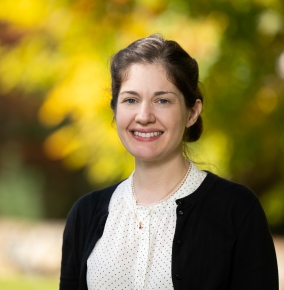Ariana Minot

When did you join Lincoln Laboratory, and what made you decide to pursue a career here?
I joined the Lab in 2017 after completing my PhD in applied mathematics at Harvard University. At Harvard, I had the good fortune of meeting several Lincoln Scholars, who introduced me to the Lab. I had been interested in pursuing a career in a national lab–type setting ever since my undergraduate research days because I enjoyed doing research and liked the team-based structure; however, I wasn't aware of Lincoln Laboratory or other Federally Funded Research and Development Centers. During graduate school, I completed an internship in the Lab's former Intelligence and Decision Technologies Group, designing natural language processing algorithms for geolocation of users in Twitter data. I found the project both interesting and challenging, and my experience motivated me to apply for a full-time position here.
What does your research focus on?
I design algorithmic techniques that will improve the reliability and robustness of Department of Defense communication systems. Often, this work involves developing new ways to process digital data and use phased arrays. Phased arrays are a set of antennas that, when properly combined, can form beams toward a specific user or radio. Such beamforming helps mitigate interference and recover noisy signals, as well as provides information on signal direction of arrival. Recent efforts include investigating how we can enable military users to reuse technologies originally developed for cellular and other applications.
One of my favorite aspects of working at the Lab is that we build prototypes and field our systems. I appreciate being able to see the full cycle of designing an algorithm, testing it in simulation, integrating the algorithm with system hardware, investigating as components inevitably break in real over-the-air data, and piecing the system back together again. Each step comes with a learning opportunity, and I am grateful to my knowledgeable colleagues, who are always glad to share their insight and experience.
How did you become interested in algorithmic work?
I entered my freshman year of college interested in pursuing genomics. But in working in a yeast genetics lab, I found the day-to-day of benchtop experimentation tedious. I took an internship with the neutrino physics group, and the data analysis and computer programming better fit my interests. In between my undergraduate and graduate studies, I spent 18 months as a Fulbright Scholar at a French national lab, where I performed statistical data analysis for the ATLAS particle physics experiment at CERN's Large Hadron Collider. I was lucky to be there when the collaboration saw the first glimpses of the Higgs boson. I learned a lot by being part of a large organization operating an extremely complicated detector with a massive code base for processing data. In graduate school, I only did simulation and theoretical analysis, so I've been very excited to be at Lincoln Laboratory, where I have plenty of opportunities to work with real data again.
What do you enjoy doing in your free time?
I have two young kids, ages five and two, who keep me busy during my free time. I enjoy going with them to the library to pick out new books and getting their "help" in the garden and kitchen.